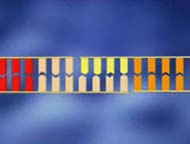
The secret of a steady hand is tightening the right muscles.
Controlling the stiffness of some of our muscles lets us manage tricky feats of manipulation, such as keeping a screwdriver in a screw, researchers have found 1 . We tune the stiffness to oppose motions in the direction of instability, such as the sideways slips that would let the screwdriver slide out of the slot.
Although demanding on the brain, this is the most energy-efficient strategy, say Mitsu

Devices with DNA software may one day be fitted into cells.
“If you wear the right glasses, a lot of what you see inside the cell is computation,” says Ehud Shapiro of the Weizmann Institute in Rehovot, Israel. Now Shapiro and his colleagues have turned the computational power of biological molecules to their own ends 1 .
The researchers have built a machine that solves mathematical problems using DNA as software and enzymes as hardware. A trillion such biomol

Evolution may make men ignorant and gullible.
Gentlemen: ignorance is bliss and gullibility is the best policy. A new mathematical analysis suggests that evolution favours babies who don’t much resemble their fathers, and males who believe their partner when she says a child looks just like him.
Anonymous-looking newborns make for uncertain fathers. But they also allow men to father children through undetected adultery, Paola Bressan of the University of Padova calculates

Researchers have discovered the mechanism by which the genetic defect underlying cystic fibrosis (CF) leads to fatal bacterial colonization of the lungs. The new findings, published today in the early online edition of the Proceedings of the National Academy of Sciences, suggest that an aerosol treatment aimed at balancing pH in lung cells could be developed to stave off or delay such infections.
The most common inherited lethal disorder in Caucasians, CF stems from mutations in a gene that

Bacteria caught mating with mammalian cells.
Cross-species coupling is generally frowned upon. But in the liberal labs of California it is actively being encouraged. Bugs that are persuaded to get down and dirty with hamster cells are rewriting sex manuals in the act.
Like humans, bacteria mate using a timely protruding phallus. It suckers a nearby bacterium and drags it close enough to shoot in DNA – a process called conjugation.
Although bacteria have been persuad

Mount Vesuvius, the volcano most famous for blanketing the towns of Pompei and Herculaneum with lava and debris in 79 A.D., may be sitting atop a reservoir of magma that covers more than 400 square kilometers, a new study suggests. The finding, reported in the current issue of the journal Science by a group of Italian and French scientists, may lead to more accurate monitoring of the area surrounding the volcano.
Building on previous work that suggested the presence of a magma zone underne

At the Berlin synchrotron radiation source BESSY II, the largest magnetic anisotropy of a single molecule ever measured experimentally has been determined. The larger this anisotropy is, the better a…

LSU quantum researchers uncover hidden quantum behaviors within classical light, which could make quantum technologies robust. Understanding the boundary between classical and quantum physics has long been a central question…

One of the biggest mysteries in science – dark energy – doesn’t actually exist, according to researchers looking to solve the riddle of how the Universe is expanding. For the…

A team led by plant biotechnologist Prof Markus Schwarzländer from the University of Münster and biochemist Prof Bruce Morgan from Saarland University has developed new biosensors with which the ratio…

How deubiquitinases USP53 and USP54 cleave long polyubiquitin chains and how the former is linked to liver disease in children. Deubiquitinases (DUBs) are enzymes used by cells to trim protein…

Conceptual blueprint to analyze experimental catalyst data. Machine learning (ML) models have recently become popular in the field of heterogeneous catalyst design. The inherent complexity of the interactions between catalyst…

How simulations help manufacturing of modern displays. Modern materials must be recyclable and sustainable. Consumer electronics is no exception, with organic light-emitting diodes (OLEDs) taking over modern televisions and portable…

“Neurons that fire together, wire together” describes the neural plasticity seen in human brains, but neurons grown in a dish don’t seem to follow these rules. Neurons that are cultured…

The quest for sustainable energy solutions has been a major focus of scientific research for decades. Solar energy, a clean and renewable source, has emerged as a promising alternative to…

Pacific Northwest National Laboratory to contribute leadership to national effort in microelectronics design and development. Microelectronics run the modern world. Staying ahead of the development curve requires an investment that…

With a processing speed a billion times faster than nature, chip-based laser neuron could help advance AI tasks such as pattern recognition and sequence prediction. Researchers have developed a laser-based…

New technology could remotely identify various types of plastics, offering a valuable tool for future monitoring and analysis of oceanic plastic pollution. Researchers have developed a new hyperspectral Raman imaging…